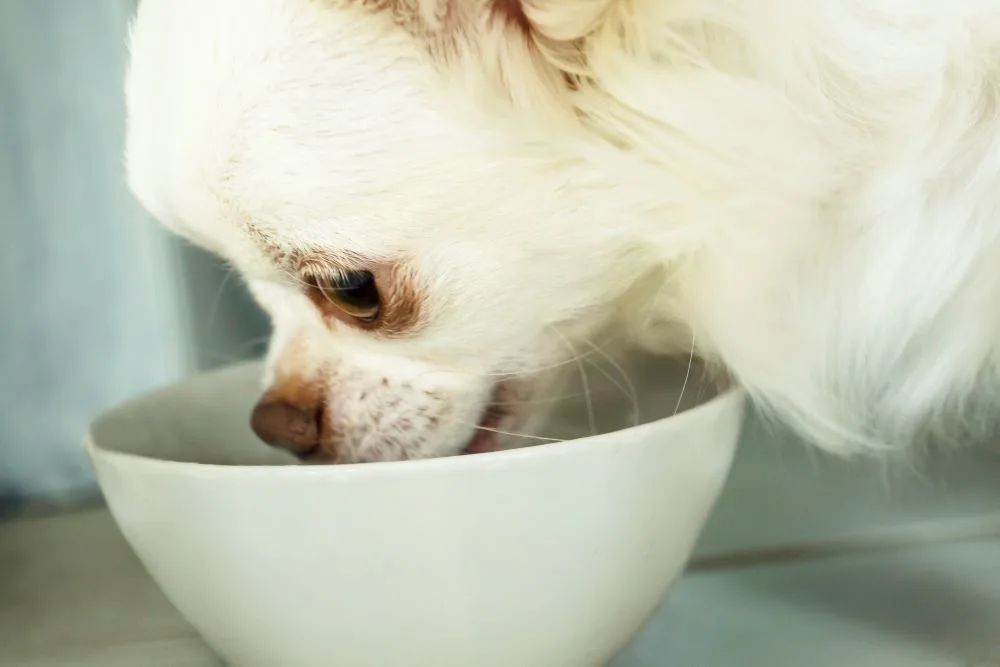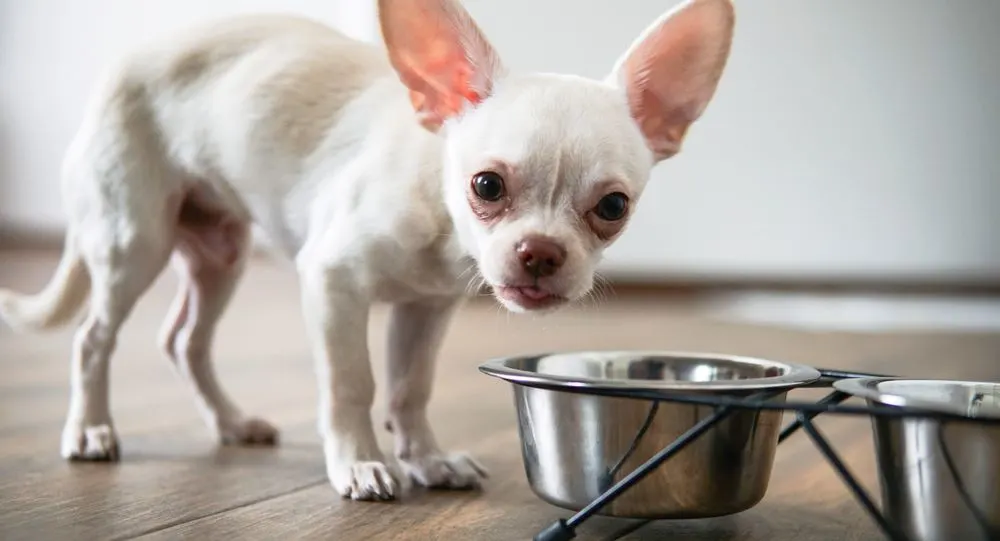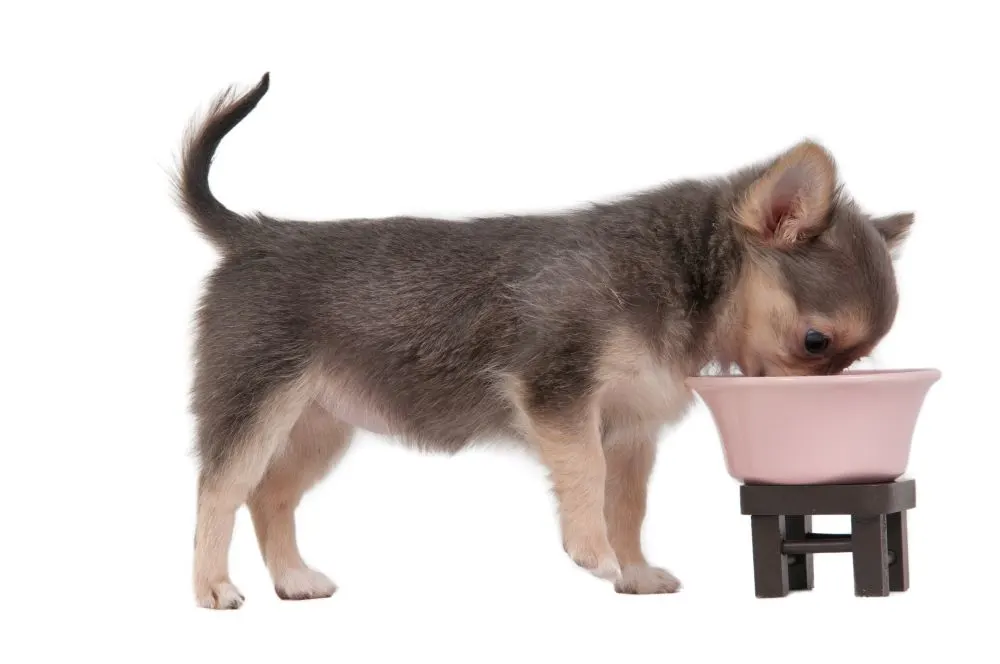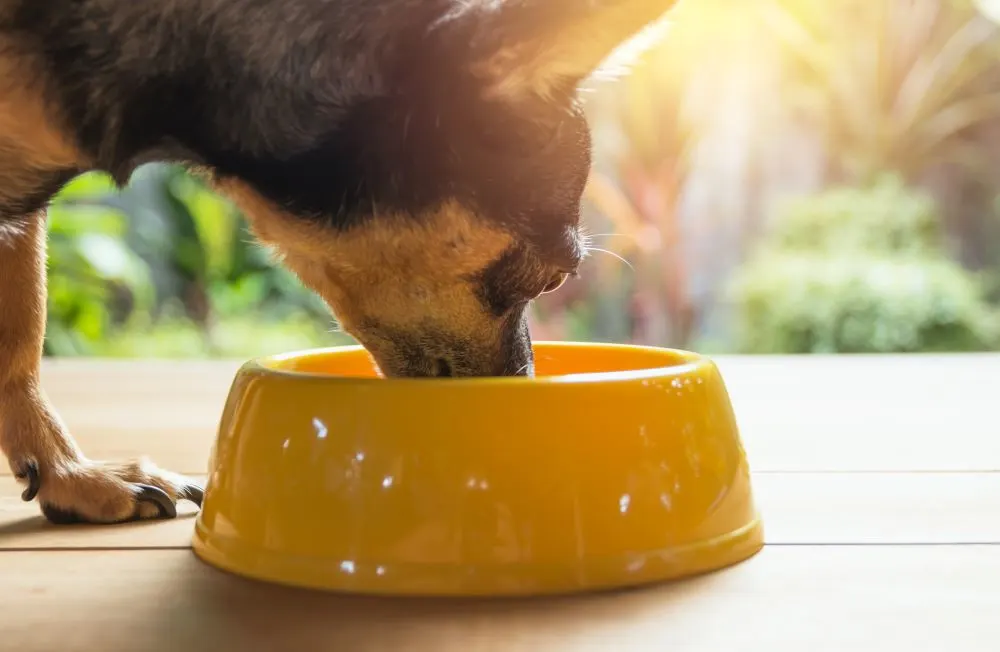There is no such thing as “people food”. Food is food regardless of who eats it. Commercial dog food companies advertise to your tastes because you instinctively know that your dog should eat food that’s also edible for humans.

But, regardless of how it’s advertised, many dog foods are made with ingredients that aren’t fit for human consumption (intestines, hooves, moldy grains, etc.).
It’s no wonder that more and more dog foods have been recalled lately. And it’s no wonder that more and more people are choosing to make their own pet foods.
This movement is good for both dogs and their owners. It gives the dog a healthier, more varied diet and it educates the owner on the benefits of eating whole foods over factory foods.

Feeding a dog a balanced diet of whole foods isn’t that much different than feeding the family. The nutritional requirements are similar. Whereas a human should eat mostly fruits and vegetables, a dog’s requirements are more like the meat and potatoes diet of the average American. The diet should be 30% to 50% protein, 30% to 50% fruits and vegetables, and 20% whole grains and other fiber.
The meats can be anything that’s available as long as it’s fresh. The least expensive are ground turkey, chicken and beef liver, and some fish Be careful with wild-caught fish, however, because the mercury content is often too high.

And, salmon should be avoided just to be doubly sure that salmon poisoning doesn’t occur. Otherwise, use whatever is available or on sale and mix it up a bit.
Variety is key. Even beans and eggs can substitute for meat every now and then. This is especially true for Chihuahuas who thrive on a high fruit and vegetable diet.
Fruits and vegetables are important in any dog’s diet regardless of the breed. The vegetables that are highest in vitamins and minerals are spinach, carrots, tomatoes, sweet potatoes, and pumpkin.
More Articles on Fruits and Veggies:
Veggies that are good for dogs
Boost your dog’s nutrition with fruits and vegetables

Many dogs do not like raw leafy vegetables so spinach is best cooked. Some vegetables like bell peppers and broccoli can cause gas so it helps to know your dog before using these.
The best fruits are those grown in temperate climates like pears, peaches, apples, and plums. (Grapes should be avoided as they have been known to cause kidney failure in dogs.
Fruit seeds and pits contain cyanide so make sure these are always removed and discarded so the dog can’t eat them). These fruits not only provide vitamins and minerals but are also great sources of fiber.
White and brown rice is one of the best grains for dog food because it is easily digested and processed the least. Basic oatmeal is also quite good. Whole-grain pastas can be used when extra calories are needed.

Although ready-made breads and cereals will not hurt a dog they tend to be fattening and include extra sugars and salt that can cause problems as the dog ages. It’s best not to feed these to your dog.
It’s necessary to keep in mind that there are certain minerals that are not available in most meats, fruits, and vegetables. Calcium is one of these and is a must for the proper development of bones, teeth, and claws.
Supplements are available in many stores but natural is best. Milk (in small quantities and goat’s milk is better than cow’s milk), cottage cheese, yogurt, and even ground egg shells can provide the necessary calcium. A good solid bone can also provide calcium as well as clean the teeth.
Fresh herbs added to the dog’s meal can add many trace nutrients as well as stimulate the digestive juices. If your dog is eating grass when let outside there may not be enough fresh herbs in their diet.

Oregano, dill, parsley, thyme, and many other fresh herbs will benefit your dog and add flavor to any recipe. Some herbs like catnip excrete a scent through the skin and may help repel fleas. Just don’t overdo it. Too much of any one thing is not good for anybody. . . even your dog.
It’s really not difficult to cook for your dog when you understand the basic needs and modify those for the specific breed. Home-cooked meals also allow the freedom to add or remove calories depending on the activity level of your dog.
And, if there are medical issues such as diabetes or asthma, you can work with your vet to create specific medically approved meals.
Of course, you should let your vet know that you are making your dog’s food. She can help you create a diet that will benefit your specific dog who is, after all, is a unique being. And it’s that uniqueness that makes cooking your dog’s food from whole foods worth the time and effort.
ALSO READ: Benefits and dangers of homemade dog food


Cathy Bendzunas
Pet Blogger

Joanne Stokes
Tuesday 30th of May 2023
I would like to make my chihuahua her food. She is 12 Can you give me the recipe of how you feed your babies and how you make their food. Her name is Zoie.
Joan Powers
Wednesday 14th of June 2023
@Cathy Bendzunas, I was glad to read your recipe because I feed something very similar but I wanted to give you a shortcut that you may not have thought of I buy boneless chicken breast and put them in a crock pot with fresh veggies like carrots, string beans and yams and add a can or two of low sodium chicken broth This is half the work and my Bear is a super picky eater He laps this up He also loves a roast beef with potatoes etc cooked in the same manner along with low sodium beef broth He loves black beans and kidney beans which I give him as a snack but I use the low sodi=um variety and rinse them very well in a colander under cold water and feed them as a snack sparingly because he tends to be a little chub He doesnt drink enough to satisfy me so a small slice of watermelon works for this problem Again thank you for validating my instincts as far as what to feed my darling Bear
Cathy Bendzunas
Tuesday 30th of May 2023
Sure. I probably need to write a post about this but until then, here it is: 1 pound ground turkey 1 can tuna 4 eggs 1 bag mixed frozen mixed veggies 2 baked sweet potatoes with skins, cubed 1/2 cup beef bone broth dog vitamins and fish oil ( I add this sometimes to the large bowl but to be more precise, it's better to add it to each dog bowl. I use Zesty Paws fish oil and Life Extension Dog Mix vitamins)
Cook up the turkey in a little olive oil if needed. Break up the turkey in tiny pieces. The last few minutes that the turkey is cooking, add the 4 eggs and mix in. In a large bowl, stir all ingredients together and store in a covered container in the fridge. For 4 dogs, this usually lasts around a week.
I give each dog 1/3 cup of this and it has completely taken away the eye staining of Lucy's eyes. It has helped with Ziggy's allergies but hasn't gotten rid of them completely.